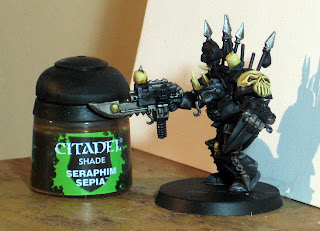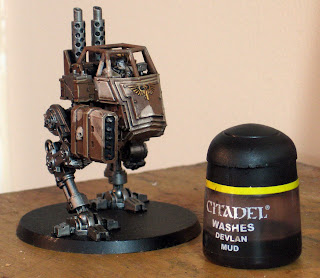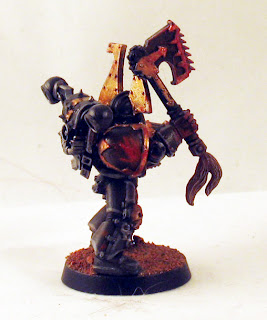How to paint gold with the new GW paints.
Following out of the Black and Bone tutorials, let's get gold out of the way. If you're doing Black Legion, these three should get most of your model done.
Step 1: Balthasar Gold
This is a Basecoat step, so make sure you coat the area rather thickly. I used to basecoat my golds with a warm brown in the older line of paints, but now there's a metallic for that.
Step 2: Gehenna's Gold
This is brighter, and has more red in it than the basecoat. The idea here is that we're working up a few layers for an overall effect that you can't get with just one step; like getting Candy Apple Red on a car. Coat this rather liberaly over the gold area, keep out of the crevices. (also note, in the model above, I based the bullet chain out of the gun, but am not taking it further. I actually want a coppery color for them.)
Step 3: Auric Armour Gold
Auric Armour is a very bright yellow color. The application will be similar to above, this isn't a highlight, we're using it as a layer... though don't lay this on too thick as it will overpower. Keep it to a thin layer.
Step 4: Agrax Earthshade
Now we're getting somewhere. With the basic gold layers all set out and looking bright and shiny, let's bring it down with some brown shade. This will give us the depth and definition we want as well as tone down the gold.
Step 5: Golden Griffon
Our final step is the highlight. Golden Griffon is a dry paint, meant to be used with a drybrush technique. With that in mind, dust this over edges and raised areas to give the gold that tarnished, aged look.
...and the gold is done!
Search All Things 40K
Monday, November 19, 2012
Monday, October 29, 2012
5-Step Bone
Step 1: Zandri Dust
Lay on the basecoat nice and thick.
Step 2: Ushabti Bone
Working with layer paints is interesting. Not thick like the base paints, you can get some good blends with little effort. This was painted in raised areas rather heavy-handed, just staying out of creases and the like.
Step 3: Screaming Skull
Screaming Skull was applied in similar fashion to the step above, but less of it, and not covering as much area. Raised areas, and large flat(ish) surfaces like the forehead of that giant skull, but staying even further away from creases in order to let some of the Ushabti Bone layer show through.
Step 4: Seraphim Sepia
Shades are my best friend. It's a shame there's only 4 glazes, otherwise I'd probably make a 6-step, but we're going to use the Sepia as both a shade and a glaze. It should smooth out the transitions between the two layer paints as well as give a nice dark shade.
Step 5: Praxeti White
This was very lightly dry-brushed over edges and the like to highlight. Don't get too heavy handed with this as there is no glaze step afterwards to smooth it out.
Labels:
Step-by-Step,
Warhammer 40k
Monday, October 22, 2012
5-Step Black
Painting black armour (or white, for that matter) always poses a problem, because you're typically missing out on either a shade or a highlight. If your midtone is white, you've got nowhere to go for a highlight. If your midtone is black, you have nowhere to go for a shade. So, what's the answer to this? For me, it's to fake to an "almost black" (and likewise, an "almost white" in the other case). Given that the new Chaos Codex came out a little bit ago, I got bitten by the bug again to get back to my Black Legion. It also helps that I just recently switched jobs to a much more sane work schedule, allowing me time to actually enjoy a hobby again, praise the Emperor.
So I've been playing around with the new paints, and I kinda like them. The "dry" paints were weird at first, but I'm really starting to dig them. In my playing around, I've found the basic guide on GW's site to actually be quite helpful (Link). Their color suggestions for "sheer black" looked promising, but after trying it out, I preferred a different order...
Step 1: Abaddon Black
Or the old "chaos black" ... same thing, new name. I generally base the whole model with this, so I rarely even call it a "step"
Step 2: Eshin Grey
I painted this over all areas that I intend to make black, while keeping it out of crevices. This is our mid-tone black, which will be made darker after the last step.
Step 3: Dawnstone
This is our first highlight. I use it to line the edges of armour that is in dark areas, and lay it on a little thicker in areas that should be brighter due to light source.
Stpe 4: Longbeard Grey
This is our second highlight. Use it sparingly, and only in areas that really need it. For example, if it's an area that was heavily applied with Dawnstone due to light-sourcing, then edge with Longbeard. If it's a darker area where you only edged with Dawnstone, don't use Longbeard.
Step 5: Nuln Oil
This should bring everything back down to a darkness that is favorable for black armour. In addition, it helps the different greys blend in a little more. We're using it as a shade AND a glaze! Bonus! :D
It might be a little hard to really see the "black" because the rest of the model is still left in its Abaddon Black basecoat, and is thus darker, so...
Here's the finished model to give you an idea of how that black fits in with the rest. It's not really the final step for this particular model, to be honest, because I like my Khorne Berzerkers a bit bloodsplattered ... but skipping straight to that step would kinda defeat the purpose of showcasing the black armour.
And here's the blood-splattered version, in-case you were wondering. :)
Let me know what you think!
Labels:
Step-by-Step,
Warhammer 40k
Monday, March 26, 2012
Step-By-Step Imperial Guard Vehicle (Sentinel)
My Imperial Guard are a brown version of the Cadian Guard. Just putting that out there before we get too deep into this and you're like "Wait a minute. That's not the right color."
I don't know what to do about this new color range GW is bringing out. I might have to put these Step-By-Steps on hold until I figure out what colors are equivalent and which ones aren't. For now, the colors are the old ones. I might post a few color comparisons when I get some of the new colors in, so we can all see just how they all line up.
Step 1: Basecoat
Also note, this model is magnetized. I'll be showing the various weapons attached throughout the tutorial.
Step 2: Calthan Brown
Step 3: Dheneb Stone
Yay for patchy camouflage!
Step 4: Skull white
This was edged/drybrushed over the areas that were painted in Dheneb (except for the bone/skull parts).
Step 5: Kommando Khaki
Edged along the Calthan Brown parts.
Step 6: Boltgun Metal
All the mechy bits got coated, as well as a few strategically placed scratches and scuffs along the armour plates.
Step 7: Shining Gold
Autocannon bullets, aquilas, winged skulls, etc. We are now ready for washes.
Step 8: Devlan Mud
This goes over all the brown, dheneb stone, and gold.
Step 9: Badab Black
This was applied to all the Boltgun Metal bits.
Step 10: Ogryn Flesh
For the little dude's face.
Step 11: Bleached Bone
This was a heavy drybrush along the skull to bring some color back.
Step 12: Skull White
A much lighter drybrush on the skull.
Step 13: Gryphonne Sepia
Applied to the sides and forehead of the skull.
Step 14: Enchanted Blue
This is the base color for the targeting lens and the pilot's visor.
Step 15: Regal Blue
Applied in the upper left area of the targeting lens and visor. The white dot will go in this area later.
Step 16: Ice Blue
This was applied as a line along the lower area of the targeting lens and visor.
Step 17: Skull White
The light-reflection dot in the dark blue region of the targeting lens and visor. While I had it out, I put the Company number on the side and painted the missile heads.
There we have it. Let me know what you think.
I don't know what to do about this new color range GW is bringing out. I might have to put these Step-By-Steps on hold until I figure out what colors are equivalent and which ones aren't. For now, the colors are the old ones. I might post a few color comparisons when I get some of the new colors in, so we can all see just how they all line up.
Step 1: Basecoat
Step 2: Calthan Brown
Step 3: Dheneb Stone
Yay for patchy camouflage!
Step 4: Skull white
This was edged/drybrushed over the areas that were painted in Dheneb (except for the bone/skull parts).
Step 5: Kommando Khaki
Edged along the Calthan Brown parts.
Step 6: Boltgun Metal
All the mechy bits got coated, as well as a few strategically placed scratches and scuffs along the armour plates.
Step 7: Shining Gold
Autocannon bullets, aquilas, winged skulls, etc. We are now ready for washes.
Step 8: Devlan Mud
This goes over all the brown, dheneb stone, and gold.
Step 9: Badab Black
Step 10: Ogryn Flesh
Step 11: Bleached Bone
This was a heavy drybrush along the skull to bring some color back.
Step 12: Skull White
A much lighter drybrush on the skull.
Step 13: Gryphonne Sepia
Applied to the sides and forehead of the skull.
Step 14: Enchanted Blue
This is the base color for the targeting lens and the pilot's visor.
Step 15: Regal Blue
Applied in the upper left area of the targeting lens and visor. The white dot will go in this area later.
Step 16: Ice Blue
This was applied as a line along the lower area of the targeting lens and visor.
Step 17: Skull White
The light-reflection dot in the dark blue region of the targeting lens and visor. While I had it out, I put the Company number on the side and painted the missile heads.
There we have it. Let me know what you think.
Labels:
Step-by-Step,
Warhammer 40k
Saturday, March 24, 2012
New Color Range
I'm sure most of you already know, but GW changed their colours. New manufacturer, new formulas, new names. I've included their conversion chart for you guys to reference, but I don't know how accurate it is. Check out how the same colour is recommended for both Dark Angels Green and Orkhide Shade. I'm skeptical.
I'll be getting some of these in the near future in order to test them out myself. The next few Step-by-Steps will probably still use the old names until I figure out what matches what.
Labels:
Warhammer 40k
Monday, March 12, 2012
Test Model: Necron Cryptek
Here's what I'm thinking for Necrons. I'm keeping the green energy effects, and I like the idea in the codex for the white faces (shown on lychguard) so much, I'm making it army-wide. Bronze-rusty main body, aged cobalt-coloured embellishments. The crystal sticking out of the snow is literally a snipped bit of sprue used to hold the Necron Warrior gun barrels.
Let me know what you think.
Let me know what you think.
Labels:
Warhammer 40k
Monday, March 5, 2012
Step-By-Step Khorne Berzerker (Black Legion)
Wow, I've been gone for quite a while and haven't really made any progress in my hobby in the time gone. It's a real bummer, but life(read:work) got in the way. Sorry for that.
Anyways, Khorne Berzerkers. For those of you that know the various armies I collect, you'll know my Chaos Space Marine army of choice is Black Legion. This presents me with a bit of a conundrum when it comes to the god-specific units. I was never really satisfied with the idea presented in the codex of simply painting a shoulderpad of the originating faction's colors (i.e. a red shoulderpad for a berzerker). You can see what I've come up with for Tzeentch's Thousand Sons here: glowing blue sorcerous runes on an otherwise Black Legion scheme. While I haven't painted up Plague Marines yet, I have done a Nurgle Sorcerer where you can see how I'd go about it. Khorne presented a different kind of challenge where I couldn't quite figure out something that was fitting. Here's what I ended up with:
Step 1: Charadon Granite
As is typical with my Black Legion, the basecoat for their armour is done in Charadon Granite.
Step 2: Fortress Grey
Edge the armour plates in this light grey.
Step 3: Boltgun Metal
All the non-gold metal bits.
Stpe 4: Badab Black
Put it on everything. This is how I like black armour. Having a base color that isn't quite black allows for some depth that you wouldn't get by simply edging on a straigh-black armour.
Step 5: Shining Gold
For that Black Legion flair.
Step 6: Mithril Silver
Drybrushed lightly over the gold bits, this will make the gold look a bit aged and worn.
Step 7: Vermin Brown
I used this on the tassel for the chain-axe, I would also use it for anything you want to appear as leather.
Step 8: Elf Flesh
Extremely light drybrush over anything based in Vermin Brown.
Step 9: Devlan Mud
This goes over anything gold and/or brown. OK, the basics for our Black Legion scheme are down, now for the Khornate part. In the end, I went with a simple option. No runes, no markings... just blood.
Step 10: Blood Red
I got out a ratty brush and spotted blood red all over his front (very little on the back). I focused on knees, hands, axe-head, face and shoulders. I wanted a real visceral feel to this, as if they almost go out of their way to spray themselves with their opponent's blood, and never bother to wash it off.
Step 11: Scorpion Green
For the eyes.
I added a bloody hand print on his shoulderpad after watching Lord of the Rings. Sauruman's Uruk-Hai did this on their faces in white paint, and it struck me as suitably barbaric that would be embraced by followers of Khorne. Now, I chose blood rather than white, and not necessarily on his face, but the result is the same: a kind of self-applied war paint in blood is how he shows his devotion. I'm planning on placing these hand-prints in various places on the squad members. Can't have too much conformity ;)
Anyways, Khorne Berzerkers. For those of you that know the various armies I collect, you'll know my Chaos Space Marine army of choice is Black Legion. This presents me with a bit of a conundrum when it comes to the god-specific units. I was never really satisfied with the idea presented in the codex of simply painting a shoulderpad of the originating faction's colors (i.e. a red shoulderpad for a berzerker). You can see what I've come up with for Tzeentch's Thousand Sons here: glowing blue sorcerous runes on an otherwise Black Legion scheme. While I haven't painted up Plague Marines yet, I have done a Nurgle Sorcerer where you can see how I'd go about it. Khorne presented a different kind of challenge where I couldn't quite figure out something that was fitting. Here's what I ended up with:
Step 1: Charadon Granite
Step 2: Fortress Grey
Edge the armour plates in this light grey.
Step 3: Boltgun Metal
All the non-gold metal bits.
Stpe 4: Badab Black
Put it on everything. This is how I like black armour. Having a base color that isn't quite black allows for some depth that you wouldn't get by simply edging on a straigh-black armour.
Step 5: Shining Gold
For that Black Legion flair.
Step 6: Mithril Silver
Drybrushed lightly over the gold bits, this will make the gold look a bit aged and worn.
Step 7: Vermin Brown
I used this on the tassel for the chain-axe, I would also use it for anything you want to appear as leather.
Step 8: Elf Flesh
Step 9: Devlan Mud
This goes over anything gold and/or brown. OK, the basics for our Black Legion scheme are down, now for the Khornate part. In the end, I went with a simple option. No runes, no markings... just blood.
Step 10: Blood Red
I got out a ratty brush and spotted blood red all over his front (very little on the back). I focused on knees, hands, axe-head, face and shoulders. I wanted a real visceral feel to this, as if they almost go out of their way to spray themselves with their opponent's blood, and never bother to wash it off.
Step 11: Scorpion Green
For the eyes.
I added a bloody hand print on his shoulderpad after watching Lord of the Rings. Sauruman's Uruk-Hai did this on their faces in white paint, and it struck me as suitably barbaric that would be embraced by followers of Khorne. Now, I chose blood rather than white, and not necessarily on his face, but the result is the same: a kind of self-applied war paint in blood is how he shows his devotion. I'm planning on placing these hand-prints in various places on the squad members. Can't have too much conformity ;)
Labels:
Step-by-Step,
Warhammer 40k
Subscribe to:
Comments (Atom)

















































